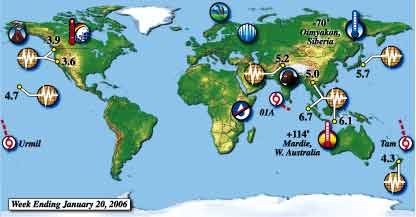Russian Winter
A severe Siberian chill descended on Moscow and the rest of
western Russia, where the mercury dropped to near minus 36 degrees
Celsius. The coldest weather in a decade was responsible for
numerous deaths from hypothermia and the evacuation of children
from a village where the heating system broke down.
By Steve Newman
Russian Winter
A severe Siberian chill descended on Moscow and the rest of western Russia, where the mercury dropped to near minus 36 degrees Celsius. The coldest weather in a decade was responsible for numerous deaths from hypothermia and the evacuation of children from a village where the heating system broke down. Temperatures inside houses in the Komi Republic village were said to be hovering around minus 10 degrees Celsius. The arctic blast coincided with the Jan. 19 Epiphany ritual, when Orthodox believers symbolically purge their sins by dipping themselves in holes cut in frozen rivers and lakes.
Eruption Continues
Alaska’s Augustine Volcano produced several more eruptions after ending 20 years of dormancy the previous week. Thick clouds of smoke and ash soared 13 km into the sky southwest of Anchorage. Vulcanologists say that the 50,000 people living near the volcano are in no immediate danger, but the U.S. National Weather Service warned those downwind to stay inside with their doors and windows closed while the ash plumes pass.
Earthquakes
Nearly 14,000 homes in southwest China’s Yunnan province were wrecked by a magnitude 5.0 temblor, centred in the impoverished county of Mojiang. Only one person was injured by the shaking.
Earth movements were also felt in northern Pakistan, Indonesia’s Flores Island, northwest Sumatra, northern New Zealand, northeastern Japan, Hawaii, Vancouver Island and the San Francisco Bay Area.
Winter Isolation
An unsually warm winter has prevented residents of northern Canada from building the usual winter ice roads, which are used to supply communities isolated during the rest of the year. “Without the winter roads, all essential goods have to be flown into the region,” said David Harper, chief of the Garden Hill First Nation. There are no conventional roads leading to the Island Lake region of Manitoba, and the winter roads over frozen lakes and rivers have traditionally been used to bring in heavier supplies, such as appliances and bulk food stocks.
East Africa Drought
The ongoing drought in Kenya, which has already killed 40 people from malnutrition or associated illnesses, is also responsible for the deaths of scores of hippos in the country’s famed Maasai Mara Nature Reserve. Between 60 and 80 hippos have died there during the past six weeks amid increased drought-related competition for scarce food and water. Kenya Wildlife Service spokesman Michael Koikai warned, “They will continue to die if this drought persists, and we will see deaths of other species, notably elephant and buffalo.” The drought has also clogged the streets and parks of Nairobi with hundreds of Masai herdsmen, who had driven their cattle into town after their usual grazing grounds dried up.
Tropical Cyclones
Weak cyclone 01A passed just south of India as it entered the Arabian Sea. Cyclones Tam and Urmil formed briefly over the open waters of the South Pacific.
Doomsday Vault
Norway plans to carve out a huge “doomsday vault” inside an Arctic mountain to store 2 million crop seeds should they ever be needed in the wake of a global disaster. The storage cave on the island of Spitsbergen will be designed to withstand catastrophes like nuclear war or large meteor impact, which would destroy the planet’s agriculture. The Global Crop Diversity Trust says there are currently about 1,400 seed banks around the world, but many are located in politically unstable countries or areas that would be unprotected by a global catastrophe. “What we’re trying to do is build a backup to these, so that a sample of all the material in these gene banks can be kept in the gene bank in Spitsbergen,” said trust spokesman Geoff Hawtin.
Delhi vs. The Monkeys
An Indian court has ordered Delhi’s civic body to catch hordes of monkeys that have menaced lawyers and court staff for years or close down the court facility entirely. The Times of India reports the judges are annoyed by the Municipal Corporation of Delhi’s failure to tackle the monkey menace at the Tis Hazari courts complex. Lawyers, their clients and court staff complain that they are under constant threat from the simians, which often go after food and snacks being carried. India’s Hindu faithful try not to harm the monkeys because one of their main deities is the monkey-faced god Hanuman. A government attempt to use keepers of langoors (black-faced monkeys) to scare off the marauding monkeys has been a failure.












